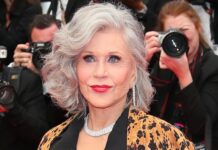When you tell people that you’re going to Deadwood, South Dakota, a common response in my part of the world (New York City) is “Oh, I didn’t realize that was a real place.” A lot of people think the town was created for the HBO series, which just got a TV movie that brought the story to a close. But Deadwood was and is real. And not only is the town real, a lot of the characters on the show were real too, and not just the famous ones like Wild Bill Hickock (Keith Carradine) and Calamity Jane (Robin Weigert), but characters like Al Swearengen (Ian McShane), Seth Bullock (Timothy Olyphant), and Charlie Utter (Dayton Callie). Their presence can still be felt in historic Deadwood, a town that has changed with the times over and over again but does everything in its power to keep its past alive.
The town hosted a special screening of Deadwood: the Movie at the Deadwood Mountain Grand hotel on Friday, May 31. Actors W. Earl Brown (Swearengen’s right hand man Dan Dority), Geri Jewell (Jewel, the maid who Swearengen looks out for), and Keone Young (Mr. Wu, the leader of Deadwood’s Chinese community) were in attendance, and after the movie Brown performed with his band the Sacred Cowboys (which I unfortunately missed because they started and ended early while I was eating a bison & elk burger). One way Deadwood keeps its rowdy past alive is through a robust drinking culture, and guests at the pre-show party were given four drink tickets. So, by the time the movie started, people were really excited to visit Deadwood again. People in Deadwood love the show, and spontaneous cheers erupted when the theme song hit, at the first appearance of Jewel, the first time Al Swearengen said “c–ksucker,” and when Bullock said to feed a dead villain to Wu’s pigs. Fans had been waiting 13 long years to get closure on the story David Milch created, and they loved every moment of it. The lady sitting next to me had tears streaming down her face after the movie’s beautiful ending.
Timothy Olyphant, Deadwood
After taping an excellent interview alongside Jewell and Young for the Legends of the Old West podcast, W. Earl Brown told me that he’d never seen Deadwood in a theater besides premieres, which are different thing, because the audience is people who are involved in the show and their friends, not fans. He loved feeling the communal energy ripple through the crowd when characters were introduced or big moments happened. “So that was enriching to have a movie theater experience for something that I was used to being told in a different way,” he said.
And as for watching it in Deadwood, that’s meaningful, too. “The ghosts are surrounding you,” he said. “I’ve been here before; this is my fourth time here. So the town’s not new to me, but to actually see the film here made it a little more special.”
Nowhere are Deadwood’s ghosts more present than at the Bullock Hotel, the hotel built in 1895 by Seth Bullock and his business partner Sol Star. The hotel is said to be haunted by the lawman’s spirit, and a man on the ghost tour I took snapped a photo of a spectral orb, while another guest said she heard a little girl scream. But in a less literal sense, the ghosts are all around in how history coexists with the present.
Deadwood’s Main Street started life as the muddy outpost depicted on the show, and many of the businesses are versions of the ones that existed back in those settler days. Al Swearengen’s Gem stands across the street from the site of his old rival Cy Tolliver’s Bella Union. There are two incarnations of the No. 10 Saloon, where Wild Bill Hickok was shot: one at the original location (also basically across the street from the Gem) and another up the street that’s filled to the brim with period memorabilia and stages campy re-enactments of the murder. The site of the Bullock Hotel has been Bullock’s since he and Star built their hardware store there in 1876. The walls of Chinatown still stand toward the end of the street. The production shot in California, but the set design crew really did their research. Real Deadwood and show Deadwood have the same scale. The biggest difference is that 2019 Main Street isn’t a filthy, stinking mud pit.
 William Sanderson, Deadwood: The Movie
William Sanderson, Deadwood: The Movie
If Main Street is where history lives, the Days of ’76 Museum is where it’s contextualized. The museum tells the story of the town, from settlement to sophistication, through historical photos that look like sepia-toned stills from the show and a vast collection of horse-drawn vehicles. It starts with the rugged wagons the earliest prospectors rode in on in 1876 after gold was discovered, and ends with the luxurious carriages the prosperous residents rode around in by the time the town was well-established with electricity and running water, less than 25 years after Wild Bill died. The carriage exhibit gives the sense of how much more of Deadwood‘s story was left to tell when it was canceled after Season 3. The town was still lawless then, and the movie, by necessity, skips forward in time over the incremental progress towards civilization. Maybe Season 4 would have covered the devastating fire of ’79, which destroyed the downtown, and its subsequent rebuilding in stone and brick, getting it closer to a place built to last.
Deadwood almost didn’t last, though. When the town’s mining industry dried up in the middle part of the 20th century, Deadwood fell on hard times, until small-stakes gaming was legalized in 1989. Then the economy was revitalized through tourism and gambling, and the vacant buildings were turned back into places where travelers could play cards and eat some red meat. The way to keep the town alive was to go back to the past.
The present keeps the past alive through taxes from gaming that get funneled into historic preservation efforts. Jill, my guide on the Deadwood Stagecoach, told me that she bought an old Victorian house for $48,000 and then received about $40,000 in grants from the town to restore it. She first came to the town because she was a fan of the show, and moved there permanently two months ago. “There’s always something going on,” she said.
Other people I met keep history alive in a different way. Jachin, my guide at the Broken Boot Gold Mine, is a sixth-generation Deadwood resident. His father is the mayor, a post previously held by local historical figures like E.B. Farnum, Sol Star, and Nathan Franklin, whose home is now the Adams House museum. His great-great-great-great-great-great grandfather is buried in Mount Moriah Cemetery, alongside Wild Bill Hickock and Calamity Jane.
For a Deadwood fan, visiting the town feels like a pilgrimage. And watching the movie that serves as the series finale there must feel like going to Mass at St. Peter’s Basilica. It makes me want to visit the diner from the Sopranos finale or a fast food restaurant in Baltimore for my next HBO historical site tour.
Deadwood: the Movie is available to stream on HBO GO and HBO NOW.
Need HBO? Add it through Hulu or through Amazon.
Source : TVGuide








